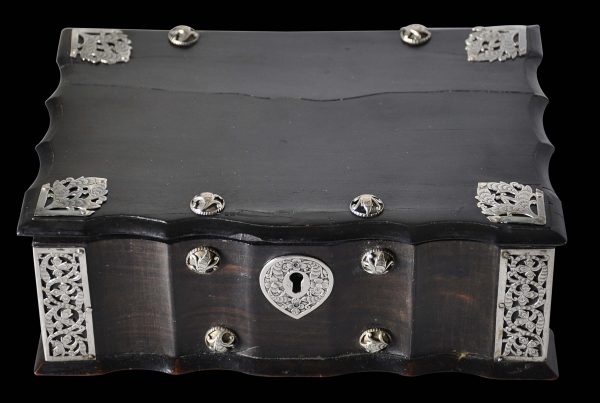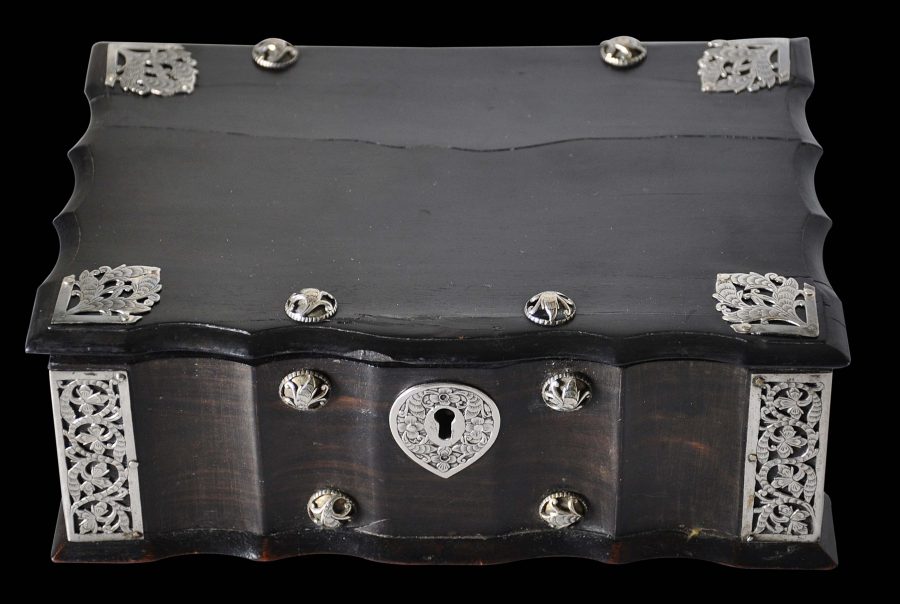This fine Dutch colonial betel or sirih box is from eighteenth century Sri Lanka and possibly Batavia, and is composed of scalloped and bevelled ebony, with silver mounts. The main silver mounts comprise pierced corner plates to the lid, the sides of the box and the tear-shaped key-plate. The corner mounts are all decorated with pierced and engraved stylised orchid scrolling. The key plate is beautifully engraved with floral scrolls.
The small bolts used in the construction of the box are hidden by unusual engraved and pierced half spheres. There are four of these on the front and another four on the sides.
Prominent metal hinge flanges are attached to the inside of the box, and matched by engraved floral flanges on the rear of the box. These attach the lid or cover to the base. An internal chain attaches the lid to the base of the box.
The Javanese and Sri Lankan habit of chewing betel was adopted by the local Dutch and exquisite boxes to hold the nut, the betel leaf and the other accompaniments were commissioned by the Dutch. The Dutch realised early on how important betel was to the indigenous people and how it was an essential part of hospitality including with the indigenous rulers. They quickly incorporated betel use with their dealings with local elites. Paintings that show the wives of Dutchmen at the time often show betel boxes prominently displayed. One such seventeenth century painting by J.J. Coeman which today hangs in the Rijksmuseum shows Batavia’s Cornelia van Nieuwenroode with her husband Pieter Cnoll and two of their nine daughters, one of who is shown holding a jewelled betel box (Gelman Taylor, 2009, p. 42).
The fashion for luxurious betel accoutrements and other finery saw the governor-general in Batavia Jacob Mossel issue a decree in 1754 stating that only the wives and widows of the governor-general, the director-general, members of the Council of the Indies and president of the Justice Council were permitted to
use gold or silver betel boxes adorned with precious stones, (Zandvlieyt, 2002, p. 206).
There are no apparent maker’s marks to the silver on the example here.
There is an old crack across the top of the lid and some small losses to the ebony here and there. A lock mechanism is present but there is no key.
References
Eliens, T.M., Silver from Batavia/Zilver uit Batavia, Gemeentemuseum Den Haag/W Books, 2012.
Krohn D.L. & P.N. Miller (eds.), Dutch New York Between East and West: The World of Margrieta van Varick, Bard Graduate Center/The New York Historical Society/Yale University Press, 2009.
Veenendaal, J., Furniture from Indonesia, Sri Lanka and India During the Dutch Period, Foundation Volkenkundig Museum Nusantara, 1985.
Veenendaal, J., Asian Art and the Dutch Taste, Waanders Uitgevers Zwolle, 2014.
Voskuil-Groenewegen, S.M. et al, Zilver uit de tijd van de Verenigde Oostindische Compagnie, Waanders Uitgevers, 1998.










